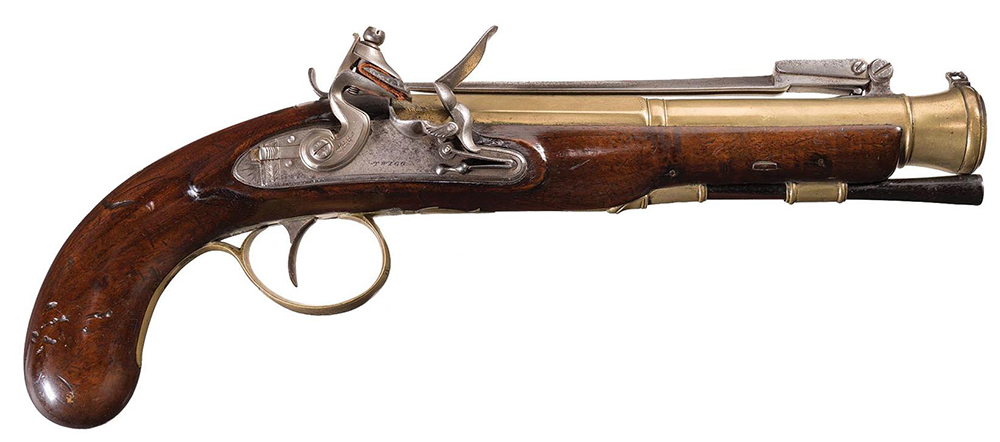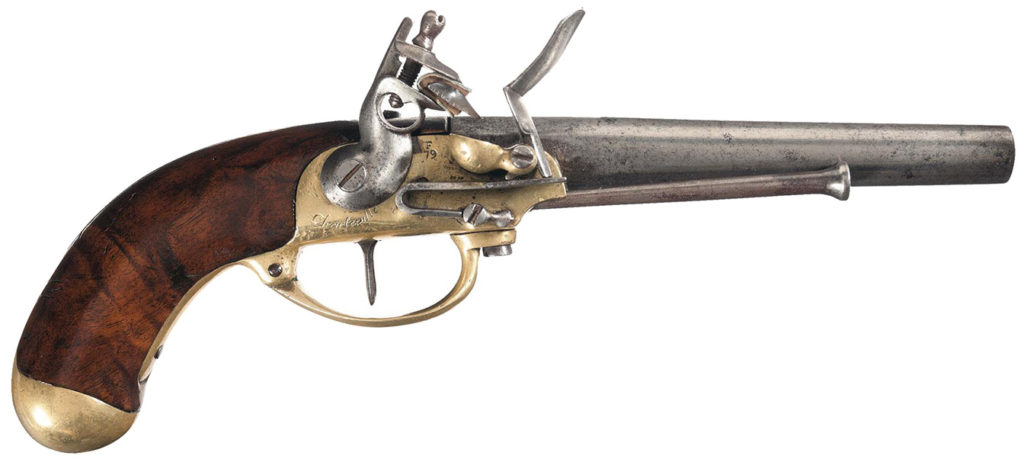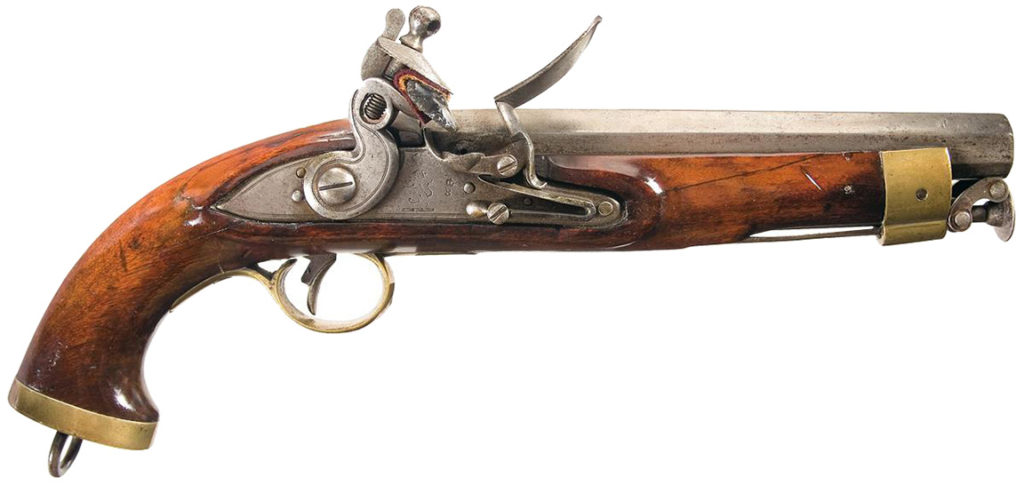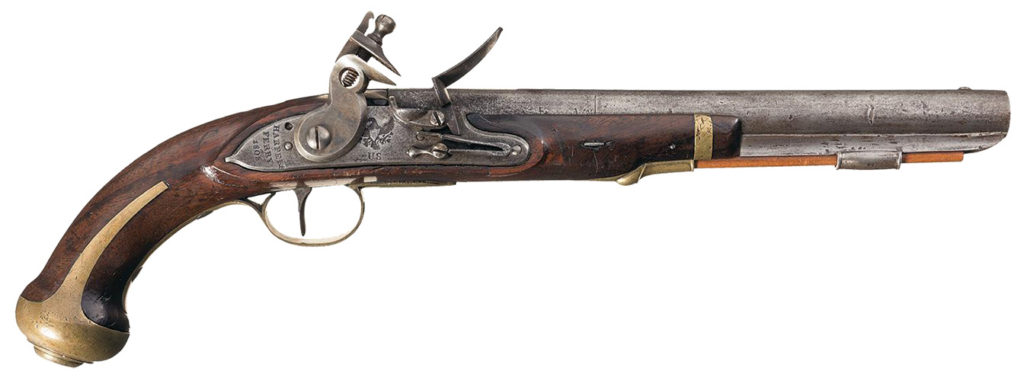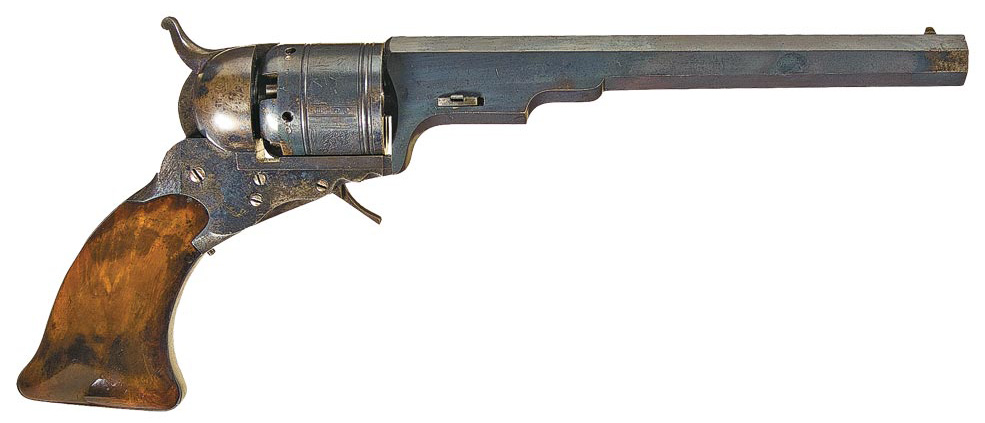White Leviathan Armory
- At August 13, 2023
- By Great Quail
- In White Leviathan
 0
0
The White Leviathan Armory
There are thousands of firearms a Keeper could introduce to a campaign set in the mid-1840s; the “White Leviathan Armory” details some of the most common models and types. (More unusual firearms such as the Elgin pistol and Whittier Revolving Rifle are profiled under “Handouts: Items.”) The Armory is organized into two sections: “I. Longarms” and “II. Pistols.” Longarms require two hands for effective use. They are generally more accurate than pistols, and include blunderbusses, shotguns, muskets, and rifles. Pistols may be fired with one hand. They are generally less accurate that longarms, but may be concealed, and are easier to maintain and keep clean.
I. Longarms
Blunderbuss
1600–1840s, muzzle-loading flintlock. Caliber .60 to .80, Base Range 10/15/20, Capacity 1, Rate of Fire 1/4, Damage 3D6/2D6/1D6, Malfunction 95.
Most commonly associated with cavaliers or sailors, the blunderbuss is distinguished by its smooth large-caliber bore, short barrel length, and conspicuously-flared muzzle, which facilitates loading from horseback or a pitching deck. Many blunderbusses have barrels made from brass, an alloy of copper and zinc more resistant to salt-air corrosion than iron. A blunderbuss is traditionally loaded with 4-6 musket balls of various calibers, but rocks, nails, and scrap metal has been known to serve in a pinch. While most blunderbusses are flintlocks, some caplock conversions exist. Existing since the days of matchlock firearms, the named blunderbuss is derived from the Dutch for “thunder pipe.”
Long Rifle, “Pennsylvania Rifle,” “Kentucky Rifle”
1700s–1800s, USA, muzzle-loading flintlock. Caliber .25 to .60, Base Range 60, Capacity 1, Rate of Fire 1/5, Damage 1D4+1 to 1D12+1, Malfunction 98.
The American love affair with the rifle started long before the Declaration of Independence was signed, and has its origins among German immigrants, who brought their superior rifling techniques to the New World when they settled in Pennsylvania. Looking to arm themselves against the wildness of the American frontier, these gunsmiths proudly established the tradition of the American Long Rifle. Although their handcrafted firearms were originally known as “Pennsylvania” rifles, as pioneers followed Daniel Boone into the west, they acquired the more enduring, if less accurate, name of “Kentucky” rifles. Designed for a wide range of calibers, Kentucky rifles are renowned for the length of their barrels, a characteristic that empowers their treasured accuracy. Indeed, there are examples of Kentucky rifles over seventy inches long and weighing ten pounds!
Intended to be passed down from one generation to the next, many Kentucky rifles are works of art, featuring polished stocks of curly maple, elaborate engravings, and decorative inlays. Most contain a patchbox in the stock, and the powder horn, leather shooting bag, and shoulder sling are often as ornately designed as the rifle they accompany. Because of their superior craftsmanship, Kentucky rifles receive a +1 to standard damage rolls.
Charleville Musket
1717–1840, France, muzzle-loading flintlock. Caliber .69, Base Range 25, Capacity 1, Rate of Fire 1/4, Damage 1D12, Malfunction 95.
Descended from the French hunting guns of the seventeenth century, the musket that would be carried by France’s soldiers for the next 120 years was first introduced as “le fusil modèle 1717.” In 1728, a third barrel band was added, and the “Charleville” musket attained the basic form it would possess all the way to the Napoleonic Wars. Exported to the American colonies, the modèle 1763 and modèle 1766 were used by colonists against the British, while the French soldiers who came over with General Rochambeau carried the new modèle 1777. Although these muskets were produced at four different locations, the Americans referred to them collectively as “Charlesville” muskets, after Charleville-Mézières, the main French armory in Ardennes. The name stuck, and even modern French sources refer to them as “fusils Charleville.” A famously sturdy gun, its three barrel bands reinforce the musket when the bayonet is attached, and during close-quarters combat, the patte de vache or “cow’s foot” stock may be used as a heavy cudgel.
Fusil modèle 1777
The most enduring model of Charleville musket was also the last, the modèle 1777, which carved a cheek-rest into the stock and introduced a handsome brass flash pan and bridle. The modèle 1777 persisted through three separate modifications, including a “correction” made by Napoleon Bonaparte in 1800 known as the “le fusil modèle 1777 corrigé en l’an IX.” With over seven million produced, the modèle 1777 was carried across Europe by Napoleon’s Grande Armée, and became the most widely-used musket in history. The modèle 1777 spawned numerous imitations, such as the Austrian Model 1798, the Prussian Model 1808, and the majority of American muskets rolling from the armories at Springfield and Harpers Ferry.
Land Pattern Flintlock Musket, “Brown Bess”
1722–1832, UK, muzzle-loading flintlock. Caliber .75 bore / .69, .705, .72 balls, Base Range 20, Capacity 1, Rate of Fire 1/4, Damage 1D12 to 1D20, Malfunction 97.
Produced for well over a century, the British Land Pattern musket was issued in many various lengths and designs, all of which were collectively referred to as the “Brown Bess.” Equipped with a .75 caliber bore, soldiers using the musket were generally issued smaller diameter balls, usually .69 or .705 caliber. This made loading considerably easier as the barrel became fouled; however, the additional windage between bore and barrel significantly reduced the accuracy of the musket. Although the Charleville musket was more exact, the British soldiers trained to use the Brown Bess were less concerned with precision than with volume. Discharging their muskets in alternating volleys, a battalion of redcoats could sustain an almost continuous wall of fire at advancing troops, sending wave upon wave of lead balls crashing into the bodies of charging crapuads, highlanders, Teagues, Punjabis, and of course, upstart colonists.
Springfield Musket, U.S. Model 1795 to U.S. Model 1840
1795–1840, USA, muzzle-loading flintlock. Caliber .69, Base Range 25, Capacity 1, Rate of Fire 1/4, Damage 1D12, Malfunction 95.
U.S. Model 1816 Type II musket, based on the French fusil modèle 1777 “Charleville” musket
Named after America’s first national armory, “Springfield” muskets were actually produced all over the United States, from the federal armories at Springfield and Harpers Ferry to the workshops of dozens of private contractors, the largest of which was Eli Whitney in New Haven. These armories continued to improve their musket patterns, and in 1799 Springfield Armory began stamping its lockplates with the now-iconic eagle. The years between 1795 and 1842 saw a wide variety of .69 caliber muskets, with increasing levels of standardization elevating the overall quality. Produced in time for a second war against Britain, the Model 1812 was based on the Charleville modèle 1777. The improved Model 1816 retained the basic Charleville pattern, with the Model 1822, Model 1835, Model 1840 muskets offering only minor improvements. The Model 1842 upgraded the Model 1840 to a caplock, and has the distinction of being Springfield’s last smoothbore musket. Starting with the Model 1855, rifles would become the order of the day. Nevertheless, many older Springfield muskets were converted to percussion locks, and more than a few were used in the first years of the Civil War.
Pattern 1800 Infantry Rifle, “Baker Rifle”
1801–1837, UK, muzzle-loading flintlock. Caliber .625, Base Range 50, Capacity 1, Rate of Fire 1/5, Damage 1D12, Malfunction 95.
After being exposed to American Long Rifles during the Revolutionary War, the British decided to experiment with rifled muskets, and eventually settled upon Whitechapel gunsmith Ezekiel Baker’s design. Loosely based on the German Jäger rifle, Baker’s final model was a full 12” shorter than the Brown Bess, and featured a 30” barrel with seven rectangular grooves. A fairly handsome firearm, the Baker Rifle sports a raised cheek-piece, a scrolled brass trigger guard, and a brass patchbox containing the crucial cleaning kit. Like all rifles, the Baker took longer to load and required more attentive cleaning than a smoothbore musket, but its increased accuracy was more than adequate compensation for the “Chosen Men” who carried it. The rifle’s most famous advocate was Lt. Colonel Richard Sharpe, whose best marksman, Daniel Hagman, once brought down a French artillerist from 700 yards away.
U.S. Model 1819 Hall Breech-Loading Flintlock Rifle
1819–1840, USA, pivoting-block, flintlock. Caliber .52, Base Range 40, Capacity 1, Rate of Fire 1/3, Damage 1D10, Malfunction 95.
In 1811, Maine inventor John Hancock Hall received a patent for a breech-loading flintlock rifle. Partnering with D.C. architect William Thornton, John Hall began producing his rifle in small numbers, until the U.S. Ordnance Bureau requested an order of two hundred. After giving it some thought, Hall suggested that he could produce an even larger order if he had access to an assembly process using precision machinery and interchangeable parts. Given the recent success of Eli Whitney employing similar techniques to Springfield patterns, the Army agreed to Hall’s proposal, but dispatched him to Harpers Ferry, where more traditional methods of manual assembly were still the norm.
Hall occupied an old sawmill adjacent to the armory on Virginius Island, the series of lots carved from the Shenandoah by various canals and millraces. Hall spent the next few years developing a quasi-independent workshop guided by the “uniformity principle.” Eventually known as “Hall’s Rifle Works” on “Hall’s Island,” the workshop used running water to power a wide variety of machine tools, and soon rivaled—some would say, surpassed—“Whitneyville” in New Haven. By 1824, Hall had produced a thousand virtually identical Model 1819 rifles, making it the first mass-produced breech-loading rifle in the world.
 Hall rifle with breechblock open and ready to load
Hall rifle with breechblock open and ready to load
In many ways, the Model 1819 is a transitional firearm, bridging the gap between muzzle-loaders and breech-loaders. In fact, Hall anticipated that some shooters may load the Model 1819 through the muzzle, so the rifling does not begin until an inch-and-a-half past the muzzle, a design that facilitates ramming a ball home. For the majority of shooters content to leave the ramrod in place, the breech is opened by pulling a hook-shaped catch protruding from the bottom of the frame. This releases the breechblock, which pivots upwards to expose the chamber. Essentially the rear segment of the barrel, its large size necessitates a wide breech, giving the Hall frame its distinctive diamond-shaped bulge. The cartridge is loaded from the front—another transitional aspect—and the breechblock is locked back down. The pan is primed, the hammer fully cocked, and the flintlock is ready to fire. The product of early machine tooling, the Model 1819 relies on tightly-engineered components to seal the breech; an imperfect system that results in significant breech blow-by and a reduced accuracy and range.
Hall Carbine, Model 1833 to Model 1842
1833–1844, USA, pivoting-block. Caliber .52 to .64, Base Range 20, Capacity 1, Rate of Fire 1/3, Damage 1D10 to 1D12, Malfunction 95.
 Model 1840 Type I Hall Carbine with “elbow” lever
Model 1840 Type I Hall Carbine with “elbow” lever
Chambered for .52 or .58 caliber rounds, the U.S. Model 1833 Hall-North Carbine was the first percussion firearm adopted by U.S. forces, and features a sliding “ramrod” bayonet. The .64 caliber U.S. Model 1836 Hall Carbine was produced in smaller numbers, and saw use against the Seminoles by the 2nd Dragoons. The Model 1840 Hall-North Carbine changed the operating lever, with the rare Type I featuring an “elbow” lever and the more common Type II equipped with a less-obtrusive “fishtail” lever.
The Model 1841 Hall Rifle retained the fishtail lever, as did the Model 1842 Hall Carbine, which added brass furnishings. John Hall continued to work at Harpers Ferry until 1840, producing over 30,000 firearms and occasionally coming into conflict with the more traditional armorers who resented this Yankee upstart and his newfangled methods. As his health declined in the late 1830s, conditions at Hall’s Rifle Works began to deteriorate, and frequent flooding inflicted excessive wear-and-tear on his precision machines. Indeed, these flooding conditions resulted in Hall developing a distinctive browning lacquer used on Harpers Ferry firearms to protect them against corrosion; a recipe that he carried to his grave in 1841.
Zündnadelgewehr, “Prussian Needle Rifle”
1841–1873, Prussia, bolt-action. Caliber 13.5 mm (.53 inches), Base Range 60, Capacity 1, Rate of Fire 1/2, Damage 1D10, Malfunction 95. Note: On a critical failure, the needle breaks and must be replaced. This action takes three rounds.
Designed by Johann Nikolaus von Dreyse in 1836, the revolutionary Zündnadelgewehr—or “needle-fired gun”—was the first breech-loaded bolt-action rifle. The rifle’s name is derived from Dreyse’s unique primer system. The .53 caliber round is encased in a .61 papier-mâché sabot, with a percussion cap located directly behind the bullet. This sabot is backed by a paper cartridge filled with 74 grains of black powder. When the trigger is pulled, a needle-like firing pin pierces the paper cartridge, passing through the gunpowder to strike the percussion cap mounted behind the bullet. Because the subsequent deflagration moves front-to-back, the gunpowder is burned more efficiently, directing its full energy into propelling the bullet. This also reduces energy lost through muzzle flash. The sabot grips the rifling of the .61 bore, spinning the bullet which departs the sabot upon exiting the muzzle.
Dreyse’s bolt assembly features a spring-activated firing pin carrier encased within the breech-bolt. To load the rifle, the user unlocks the breech-bolt by depressing a spring-catch located at the rear of the bolt assembly. This releases the tension on the carrier, which pops from the rear of the bolt assembly. The breech is exposed by pulling back the bolt assembly using a knob-tipped handle. The bore is accessed through a truncated conical opening at the front of the breech. The shooter brushes away the charred remains of the previous paper cartridge and inserts a new cartridge into the bore. The bolt is pushed forward and locked down using the knob. Because the leading end of the breech-bolt features a recessed ring, it slides over the conical lip of the bore, forming a rudimentary gas seal. Finally, the shooter manually sets the firing pin by pushing the protruding carrier back against the spring and locking it into place. When the trigger is pulled, the needle drives forward to pierce the cartridge and fire the round.
As revolutionary and as effective as it was, Dreyse’s rifle suffered from several disadvantages. Its main weakness was the needle itself, which was surrounded by exploding gunpowder every time the trigger was pulled. After about two hundred firings, the needle simply broke, leaving the rifle without a firing pin. Fortunately, the needles were easy to replace. Encased within a thin brass sheath, the firing pin was unscrewed from the carrier, and a fresh needle was swapped for the damaged one. Less easily amended was the problem of breech blow-by, which resulted in troops failing to properly aim the rifle, often preferring to shoot from the hip rather than risk a scorched face. Finally, the rifle weighs over eleven pounds, which makes it tedious to carry and difficult to aim without support.
II. Pistols
Blunderbuss Pistol, “Dragon”
1600s–1800s, muzzle-loading flintlock. Caliber .60 to .80, Base Range 5, Capacity 1, Rate of Fire 1/4, Damage 3D6/2D6/1D6, Malfunction 95.
Dating from the days of matchlocks, the blunderbuss pistol was originally called a dragon, which is the origin of the word “dragoon.” Most commonly associated with cavaliers or sailors, the blunderbuss pistol is distinguished by its smooth large-caliber bore and conspicuously-flared muzzle, which facilitates loading from horseback or a pitching deck. Many blunderbusses have barrels made from brass, an alloy of copper and zinc more resistant to salt-air corrosion than iron. While it can be loaded with a single high-caliber ball, its customary to cram a few lower-caliber balls into the barrel to better “sweep the decks.” Most blunderbusses are flintlocks, but caplock conversions exist.
Land Service Pistol, “English Dragoon,” “Heavy Dragoon”
1720s–1790s, UK, muzzle-loading flintlock. Caliber .56 to .66, Base Range 10, Capacity 1, Rate of Fire 1/4, Damage 1D8 to 1D10, Malfunction 95.
The origins of the “dragoon” pistol may be traced to the dragon, a wheel-lock blunderbuss carried by seventeenth-century French mounted infantry. As the role of mounted soldiers became more specialized, their firearms evolved with them, and by the late eighteenth century most European armies featured “dragoon” units trained in aggressive cavalry tactics. These horsemen were usually armed with a saber, a carbine, and a brace of fearsome pistols. The dragoon kept his pistols in leather holsters located forward the pommel of his saddle, where they could be easily drawn and fired from horseback. Dragoon pistols were known for their long barrels—sometimes up to 14” or more—and their metal buttcaps, usually reinforced by extended “ears” and designed to crush an opponent’s skull.
While the British had a long tradition of high-quality firearms, there was little standardization across their armed forces, a problem that resulted in confusion and disorder as the Empire spread across the globe. In the early eighteenth century, Britain acted to standardize the weapons carried by the King’s soldiers and sailors. The Land Pattern musket, or “Brown Bess,” was used as a template for a new generation of firearms, including the Land Pattern pistol, first produced in the 1720s and partly inspired the baroque designs of Prussian firearms. Known generally as the “English dragoon pistol,” the gun is nearly 20” long, weighs four pounds, and sports a 12” barrel. Featuring a brass trigger-guard and buttcap with elongated ears, the pistol’s most distinctive feature is the raised wood around the lockplate and the Brown Bess-style “swell” to the forestock. The pistol was issued in two bore sizes. Although the actual measurements varied from maker to maker, “pistol” bore was nominally .56 caliber and “carbine” bore was .66 caliber. After Colonel Elliot’s shorter version was introduced in 1759, the original pistol became known as the “heavy dragoon.” Produced for many decades in numerous variations, the English dragoon pistol was used from the Battle of Culloden Moor to the American Revolution, where it was carried by Loyalist and Patriot alike. It was also a popular pirate weapon!
Sea Service Pistol
1716–1815, UK, muzzle-loading flintlock. Caliber .54 to .69, Base Range 10, Capacity 1, Rate of Fire 1/4, Damage 1D8 to 1D10, Malfunction 95.
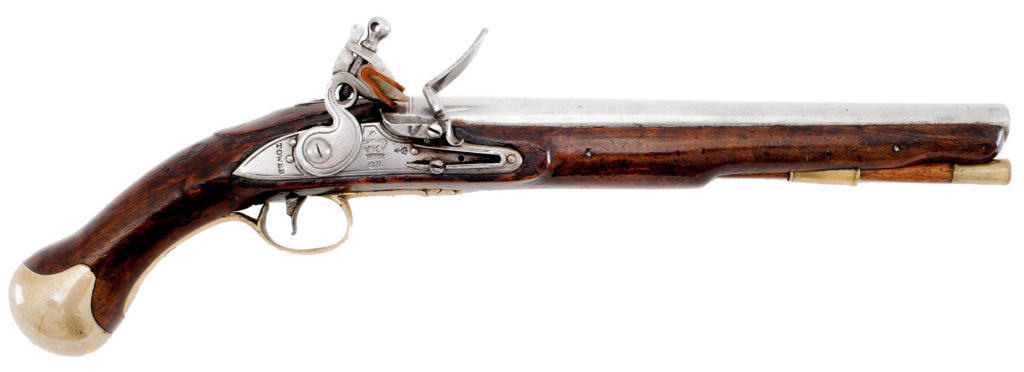 British Sea Service Pistol, 12” barrel, Tower Armory 1805
British Sea Service Pistol, 12” barrel, Tower Armory 1805
Until the early part of the eighteenth century, British sailors and Naval officers simply used whatever pistols they acquired on land, usually dragoon pistols designed to be fired once and then used as a club. The same drive toward standardization that brought about the Land Pattern musket also impacted the Royal Navy, and in 1716 the first “Sea Service” pistols were issued. Similar to the English dragoon pistol, the original Sea Service pistol sports a 12” barrel, but is fitted with a more conventional brass buttcap and lacks the distinctive stock swell. The hammer is reinforced with a “ring-neck” element, and the left side is fitted with a steel belt hook. In the 1790s, the East India Company shortened the barrel to 9”, making the pistol a more manageable length for shipboard combat. This barrel length was adopted for subsequent versions of the pistol, which carried British sailors all the way through the Napoleonic Wars.
Pistolet modèle 1777, “Charleville”
1777–1840, France, muzzle-loading flintlock. Caliber .69, Base Range 10, Capacity 1, Rate of Fire 1/4, Damage 1D10, Malfunction 95.
Patterned on the firelock used by the modèle 1777 “Charleville” musket, this French pistol sports a 7½” long steel barrel. The left side features as steel belt hook, with all the other furnishings made from brass, including the lockplate, primer pan, trigger-guard, and buttcap. The pistol lacks a forestock, the steel ramrod fitting into a slot located at the lower right side of the frame. Brought to the United States during the American Revolution, the Mle. 1777 was borrowed as the template for the first American pistol, the U.S. Model 1799. Although admired by the American patriots, the Mle. 1777 was not as beloved by Revolutionary troops back home, who preferred the earlier Mle. 1863/66. After the French arms industry fell to Revolutionary forces, many French armories continued to manufacture the earlier model until the turn of the century. As a result, Napoleon’s officers and dragoons carried a mix of pistols on their campaigns across Europe.
New Land Pattern Cavalry Pistol
1796s–1815, UK, muzzle-loading flintlock. Caliber .71 bore/.69 balls, Base Range 8, Capacity 1, Rate of Fire 1/4, Damage 1D10, Malfunction 95.
First developed by the East India Company for their private army, the New Land Pattern Cavalry pistol was an attempt to create a light dragoon pistol for all British mounted and artillery units. Easily distinguished from Elliot’s model by its flat buttplate and lanyard ring, the New Land Pattern pistol was the main British handgun of the Napoleonic era. As with many firearms of this period, variations exist, with barrels ranging from seven to nine inches and bores from .62 to .69 caliber. The pistols arming the units of the East India Company sport a prancing lion stamp on the lockplate.
U.S. Model 1805 Pistol, “Harpers Ferry Pistol”
1806–1808, USA, muzzle-loading flintlock. Caliber .54, Base Range 10, Capacity 1, Rate of Fire 1/4, Damage 1D8, Malfunction 95.
The first military handgun manufactured at a Federal armory, over four thousand Model 1805 flintlocks were produced at the newly-established Harpers Ferry Armory between 1805–1808. Intended primarily for officers, the pistols were produced in matched pairs and issued with identical serial numbers. Loosely modeled on the English dragoon pistol, the Model 1805 has a 10-1/16” barrel supported by a stock of black walnut. The pistol features a sturdy, ring-necked hammer, a brass-tipped hickory ramrod, and an eagle stamp on the steel lockplate. The furnishings are all brass, including a brass buttcap with elongated ears. Known as the “Harpers Ferry pistol,” the Model 1805 was quite popular, handsome and sturdy, and saw use during the War of 1812.
Ethan Allen Percussion Pistols
1836–1871, USA, muzzle-loading caplock. Caliber .28 to .45, Base Range 10, Capacity 1, Rate of Fire 1/3, Damage 1D4 to 1D8, Malfunction 97.
 First Model Allen Pocket Rifle, with rare 10” barrel with sights
First Model Allen Pocket Rifle, with rare 10” barrel with sights
One of the most storied names in American firearms is Ethan Allen. Of no relation to the Revolutionary War hero of the same name, Ethan Allen of Massachusetts was manufacturing cutlery in North Grafton when he was contracted to produce a cane gun by one Dr. Roger Lambert. Inspired by the project, Allen began producing underhammer “pocket rifles,” earning his first patent in 1837 for a “tube hammer” percussion pistol fired using a curved, tubular side-hammer. Partnering with his brother-in-law Charles Thurber, the inventor of the first typewriter, “Ethan & Thurber” began producing a wide range of firearms.
An early proponent of interchangeable parts, Ethan Allen produced thousands of guns, ranging from his famous pepperbox pistols to the novel Drop Breech Rimfire Rifle. His guns were prized for their high quality, and often featured elaborate engravings, furnishings of German silver, and handsome grips of ivory, pearl, or rosewood. Although Allen is best known for his pepperbox pistols, he created numerous breech-loading pistols in a wide variety of styles: underhammers, tube-hammers, bar-hammers, and side-hammers; ring triggers, standard triggers, and spur triggers; single, double, and even triple-barreled.
Colt No. 5 Holster Pistol, “Colt Paterson”
1836, USA, percussion revolver, single action. Caliber .36, Base Range 20, Capacity 5, Rate of Fire 1, Damage 1D6, Malfunction 97. Notes: Reloading a Paterson takes five minutes. See “Chain Fire” below for details on malfunctions.
Patented by Samuel Colt in 1836 and manufactured in Paterson New Jersey, the Colt “Paterson” has the distinction of being the world’s first mass-produced revolver. Colt claims he was inspired by a nautical pawl-mechanism he glimpsed during his 1830 voyage to India; others less charitably suggest his inspiration was the Collier revolving flintlock he saw while touring the Tower armory in England. Although the sidearm was originally fitted for .28 caliber, the .36-caliber “No. 5 holster pistol” quickly became the standard model. This model is also significantly easier to load, featuring a loading lever and capping window that replaces the previous need to partially disassemble the revolver to access to the cylinder. One of the most unusual aspects of the Paterson is its trigger, which is folded inside the pistol until the hammer is cocked. Prone to malfunction and fitted with a somewhat awkward grip, the Paterson gained little widespread acceptance. However, the Republic of Texas purchased almost 200 Paterson revolvers for use in the Texas Navy. After the Navy was disbanded, the pistols were issued to the Texas rangers, and begun to see use on the frontier. This lead to the No. 5 earning the incongruous nickname of “Texas Paterson.”
The Revolving Mechanism
Colt’s mechanism set the standard for the next few decades. The cylinder of a Paterson revolver is not drilled all the way through, and is loaded from the front. At the rear of each chamber is a percussion nipple. The user fills each chamber with a powder charge, then pushes in the bullet with his thumb. A loading lever is used to seat the shot firmly in place. Once the cylinder is loaded, the user places individual percussion caps on the nipples at the rear of the cylinder. To fire the revolver, the user cocks the hammer, which rotates the cylinder and releases the trigger. Pulling the trigger drops the hammer onto the percussion cap, which ignites the powder in the chamber and discharges the round. The user must then re-cock the hammer to index a new chamber. This mechanism is referred to as “single action,” because the trigger only performs a single action—dropping the hammer. As should be obvious, a potential danger is posed by leaving the hammer on a loaded chamber; for this reason, many shooters leave one chamber empty. It’s also customary to point the revolver vertically when cocking the hammer; this allows the spent percussion cap to fall unobstructed to the ground.
Chain Fire
The Colt Paterson is subject to “chain fire” in which a spark from a discharged cylinder ignites one or more adjacent cylinders. This causes 1D4 hit points of damage to the user for each loaded cylinder, and damages the revolver. (It may be repaired in a few hours with proper tools and a Hard Mechanical Repair roll.) Shooters usually prevent chain fire by greasing the chamber rims with lard or tallow. Failing to grease the cylinder triggers chain fire on a normal malfunction; while a greased revolver only chain fires on a roll of 00.
Sources & Notes
Books
To create this resource, I leaned heavily on Norm Flayderman’s Flayderman’s Guide to Antique American Firearms. Featuring photographs and detailed descriptions of thousands of antique firearms, this is an essential resource for any historical gaming campaign, and Flayderman’s Guide introduced me to several of the more bizarre weapons described in the White Leviathan Armory. To flesh out some of the statistical details, I turned to John Walter’s Rifles of the World. I also recommend Dennis Adler’s Guns of the American West and David Miller’s Illustrated Book of Guns. Both feature historical notes and full-color illustrations of vintage firearms, many of which are museum pieces photographed especially for these books.
Internet
Of course, the Internet was crucial for my research. The Web is filled with antique firearm collectors, and much of the information in the Armory was gathered from gun-ownership forums, antique auction sites, and the homepages of Revolutionary War and Civil War reenactors. Anyone interested in the historical firearms described in the Armory can find a wealth of additional information online, including videos of many of these guns being loaded and fired—sometimes by authentically-costumed reenactors! But without a doubt, the most useful resource on obscure firearms is Ian McCollum’s Forgotten Weapons. Perpetually cheerful and possessing a dry sense of humor, McCollum works in conjunction with auction houses to produce short videos spotlighting authentic antique firearms. McCollum explains their history, carefully reveals their inner workings, and sometimes takes them to the firing range. I also relied on Wikipedia, Antique Arms, and the Firearms History, Technology & Development blog.
Image Credits
Many of the photographs of firearms used in the Armory have been “borrowed” from online sources. Because most owners of vintage firearms are good-natured folk with a passion for promoting their hobby, I have no doubt they’ll be happy to see their photographs used to promote a wider understanding of antique weaponry. Having said that, if anyone is offended that I’m using an image without proper authorization, please contact me and I’ll remove it immediately. Many photographs depict modern reproductions, usually manufactured by Uberti, Pietta, Pedersoli, Cimarron, Taylor’s, or Dixie Gun Works. I favor these photographs because they make the gun look contemporary, something a player character might purchase in a gun store or pry from the cold, dead fingers of his enemy. When I could not find a shiny new replica, I usually turned to vintage gun auctions. The four best resources for detailed images of antique firearms are the Rock Island Auction Company, James D. Julia Auctioneers, College Hill Arsenal, and the Collectors Archives from Collectors Firearms, Inc. Thank you!
Specific Online Sources
The following sites were invaluable in creating this resource: Joseph G. Bilby’s The Brown Bess Musket for Warfare History Network, The Eli Whitney Museum and Workshop, Harry Ridgeway’s collection of percussion caps, Craig L. Barry and Curt-Heinrich Schmidt’s U.S. Percussion Rifle, Model 1841 for “Wearing of the Gray,” College Hill Arsenal’s (now-defunct) entries on the Mle. 1733 pistolet and the Elliot “Light Dragon” pistol, the entry on the Mle. 1763/66 at Military Heritage, Phil Spangenberger’s A Pistol for Dragoons from True West magazine, and the monograph Simeon North: America’s First Official Pistol Maker of the United States, by S.N.D. North & Ralph H. North, Rumford Press 1913.
Personal Note
I am myself a black powder enthusiast, and own several flintlock rifles and black powder revolvers. This means some of the notes on firing these weapons comes from personal experience; and let me tell you, I have no idea how a skilled Redcoat was able to get off 2-3 volleys per minute! I for one would prefer a Henry repeater any day of the week; but that’s a different game!
White Leviathan > Auxiliary Materials > Firearms
[Rule Modifications | Notes on Period Firearms | White Leviathan Armory]
[Back to Notes on Period Firearms | White Leviathan TOC | Forward to Books and Grimoires Introduction]
Author: A. Buell Ruch
Last Modified: 13 August 2023
Email: quail (at) shipwrecklibrary (dot) com
White Leviathan PDF: [TBD]










